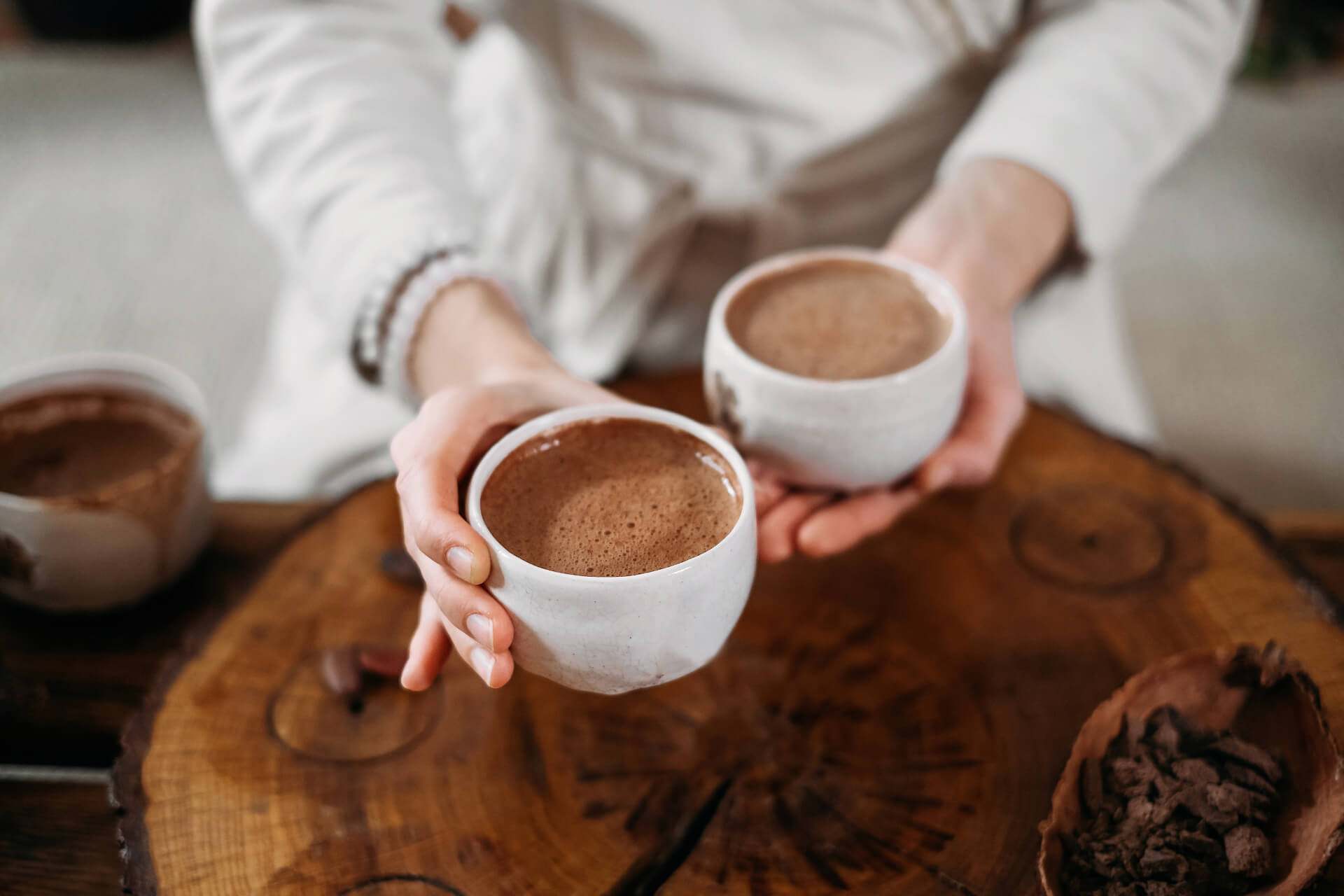Cacao, often confused with cocoa, is celebrated not just for its rich taste but also for its impressive health benefits.
Made from raw beans, cacao is packed with vital plant compounds known as flavonoids.
These compounds can help lower blood pressure, improve blood flow, and prevent blood clots, making cacao a heart-healthy treat.
Beyond heart health, cacao is rich in essential minerals such as magnesium and iron.
Just one tablespoon of cacao powder can provide a significant portion of daily magnesium needs, which is vital for muscle and nerve function.
The antioxidant properties of cacao also play a role in reducing inflammation and protecting cells from damage.
Cacao’s benefits extend to mental and cognitive health too.
The compounds found in cacao may help improve mood and cognitive function, making it a great addition to a balanced diet.
Whether enjoyed as a hot drink or used in recipes, cacao provides a delicious way to boost overall health and wellness.
History and Origin of Cacao
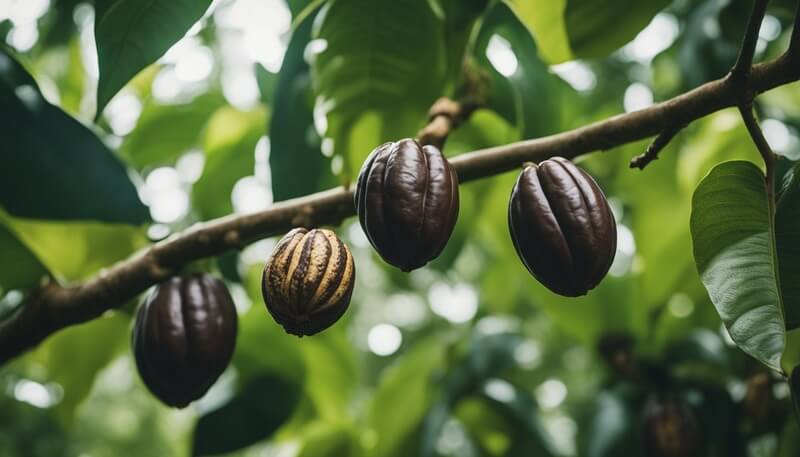
Cacao has been vital to many cultures and has a rich history that spans thousands of years.
From its beginnings as a native plant in the Amazon rainforest to its global spread, cacao has had significant cultural, economic, and health impacts.
From Theobroma Cacao to Modern Chocolate
The cacao tree, Theobroma cacao, is native to the Amazon rainforest in South America. Its fruit, the cacao pod, contains seeds, which are the raw material for chocolate.
The domestication of cacao began 5,300 years ago by the Mayo-Chinchipe culture in present-day southeast Ecuador.
When the beans are harvested, they undergo fermentation, drying, and roasting. This transforms the seeds into cacao, the primary ingredient in modern chocolate.
Over time, cacao was turned into various products and recipes, and it is enjoyed worldwide.
Related: Cacao vs Cocoa
Cacao in Mesoamerican Culture
Cacao played a crucial role in the cultures of ancient Mesoamerican civilizations.
The Olmecs of southern Mexico were among the first to consume cacao, which they passed on to later cultures like the Maya and Aztecs.
For the Aztecs, cacao beans were so valuable they were used as currency and in religious ceremonies.
Related: What is a cacao ceremony
The Maya prepared a cacao drink called “xocolātl,” which translates to “bitter water,” using ground cacao beans mixed with water, spices, and sometimes honey.
Archaeological evidence shows cacao residue in vessels, indicating its consumption was widespread and culturally significant in Central America.
The Spread of Cacao Globally
When Spanish explorers arrived in the Americas, they encountered cacao and brought it back to Europe.
Initially, it was an exotic luxury for the European elite. Over time, knowledge of cacao spread, and European colonists established cacao plantations in the Caribbean and Africa, where it became a major agricultural product.
The demand for cacao grew, leading to innovations in chocolate production and the development of the sweetened, solid chocolate that is popular today.
Today, cacao production is a global industry, with countries in Africa, like Ivory Coast and Ghana, significant producers alongside traditional South American producers.
The Nutritional Profile of Cacao
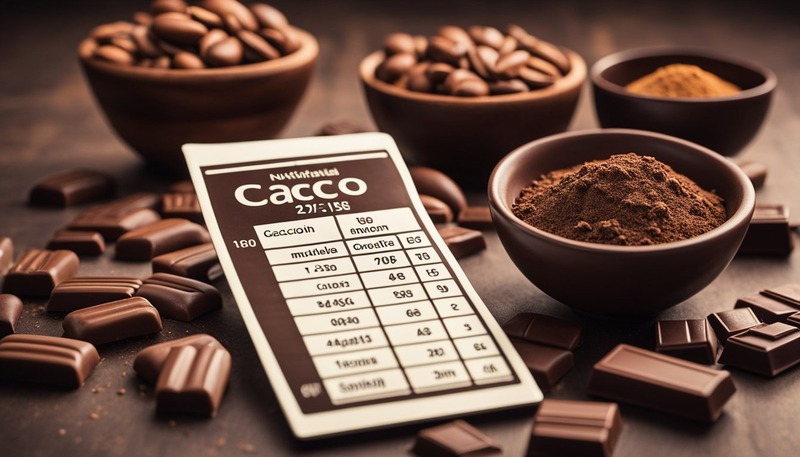
Cacao beans are rich in various nutrients that contribute to their health benefits. They include essential vitamins, minerals, protein, fiber, and important fat constituents.
Vitamins and Minerals in Cacao Beans
Cacao beans are packed with essential minerals that support numerous body functions.
- Magnesium is abundant in cacao, playing a crucial role in muscle function and energy production.
- Iron helps transport oxygen to the blood.
- Other essential minerals include manganese, which aids in bone formation and metabolism, and phosphorus, which is necessary for healthy bones and teeth.
- Zinc supports immune function and wound healing, while copper and potassium are vital for maintaining nerve function and electrolyte balance.
- Cacao beans also have small amounts of calcium and selenium, which are essential for bone health and antioxidant defenses.
Protein and Fiber Content
Cacao beans are a good source of both protein and fiber.
The protein found in cacao supports muscle repair and growth. A typical serving provides a moderate amount of protein, making it beneficial for those looking to increase their protein intake from plant-based sources.
Fiber is another significant component of cacao beans. Cacao powder contains a high amount of dietary fiber, especially soluble fiber, which aids digestion and promotes a healthy gut.
It also helps in regulating blood sugar levels and lowering cholesterol.
Calories and Fat Constituents
Cacao beans are relatively low in calories, considering their nutrient density. They provide a rich flavor and a modest amount of fat.
The fats in cacao are primarily healthy fats, including monounsaturated and saturated fats.
Cacao contains theobromine, which has stimulant properties similar to caffeine but milder.
The fat profile of cacao includes a significant portion of stearic acid, a type of saturated fat that doesn’t raise cholesterol levels like other saturated fats.
These fats contribute to energy intake and can help maintain healthy skin and cell membranes.
Cacao and Heart Health

Cacao offers multiple benefits for heart health, including lowering blood pressure and improving cardiovascular function. The compounds found in cacao can also impact cholesterol levels and reduce the risk of heart disease and stroke.
Cacao’s Impact on Blood Pressure
Cacao is rich in flavonoids, natural compounds that can help lower blood pressure.
These flavonoids aid in producing nitric oxide, a molecule that helps relax blood vessels.
Relaxed blood vessels allow more effortless blood flow, reducing the strain on the heart.
Regular consumption of cacao can help maintain healthy blood pressure levels.
Studies have shown that incorporating small amounts of high-flavanol cacao into the diet can significantly drop blood pressure. This can further reduce the risk of heart attack and stroke.
Flavanols and Cardiovascular Function
Flavanols in cacao are particularly beneficial for cardiovascular health.
They help improve blood flow to both the brain and the heart.
Better blood flow means more oxygen and nutrients reaching vital organs, crucial for maintaining overall heart health.
High-flavanol cacao has been shown to improve endothelial function.
The endothelium is a thin membrane lining the inside of the heart and blood vessels. Its improved function helps prevent blockages, reducing the risk of cardiovascular diseases.
Cholesterol and Cacao Consumption
Cacao can also affect cholesterol levels.
Regular consumption of cacao can lower LDL (bad) cholesterol while raising HDL (good) cholesterol.
Lower LDL levels mean less plaque buildup in the arteries, which can help prevent heart disease.
In addition to improving cholesterol levels, cacao’s antioxidant properties help protect against oxidative stress.
This protection helps prevent damage to the cardiovascular system.
Therefore, including cacao in the diet supports a healthier heart by balancing cholesterol levels and reducing artery plaque.
Antioxidant Properties of Cacao
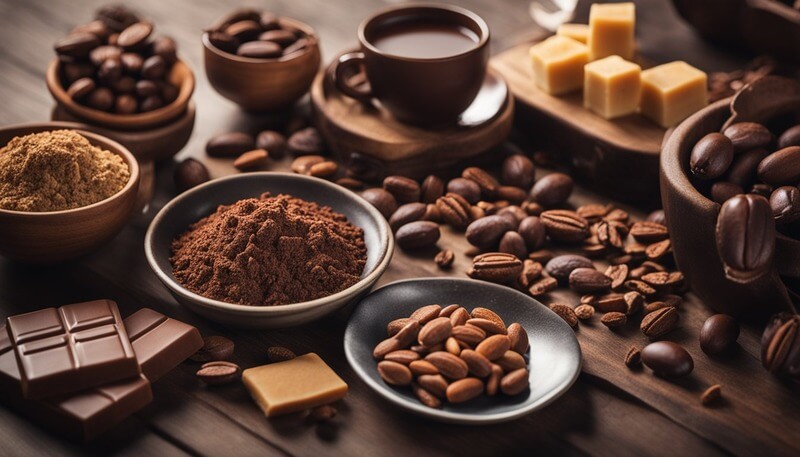
Cacao is known for its potent antioxidant properties, primarily due to its high content of polyphenolic compounds. These compounds are crucial in neutralizing harmful free radicals in the body.
Fighting Free Radicals with Cacao
Free radicals are unstable molecules that can cause cellular damage, leading to chronic diseases and aging.
Cacao’s high antioxidant content helps combat these free radicals.
Rich in flavonoids, particularly catechin and epicatechin, cacao stabilizes free radicals before they cause harm.
The flavonoids in cacao improve overall health by reducing oxidative stress.
Studies have shown that the antioxidants in cacao powder can lower inflammation and improve heart health.
Incorporating cacao into the diet offers a delicious way to boost antioxidant intake.
Cacao’s Polyphenolic Compounds
Cacao’s polyphenolic compounds, including procyanidins, play a significant role in its antioxidant capabilities.
These compounds exhibit potent antioxidant activity, aiding in preventing cellular damage.
Procyanidins, a type of flavonoid, contribute to reducing oxidative stress and inflammation.
Research highlights the benefits of cacao’s polyphenols in promoting vascular health.
The polyphenols in cacao enhance the production of nitric oxide, which helps maintain healthy blood vessels.
Consuming cacao products such as cacao nibs and powder can effectively obtain these beneficial compounds.
Cacao’s Effects on Blood Sugar and Diabetes
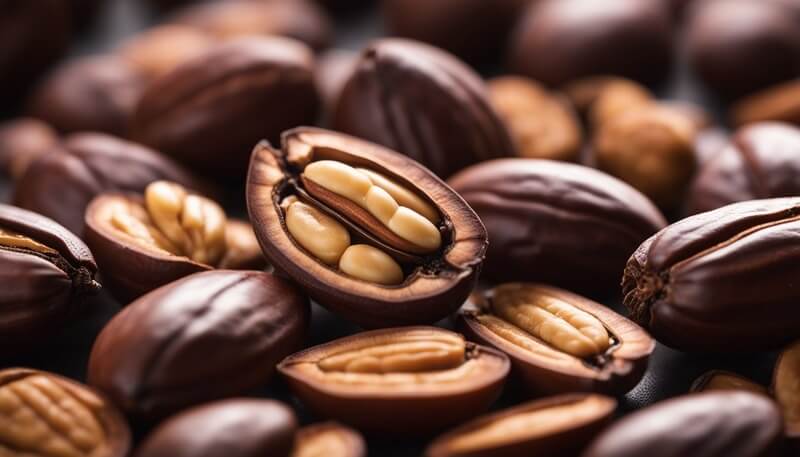
Cacao has been shown to have potential benefits for both regulating insulin levels and managing type 2 diabetes risks. These benefits are mainly due to the flavonoids found in cacao.
Regulation of Insulin Levels
Cacao contains flavonoids that can help in improving insulin sensitivity.
Studies suggest that these flavonoids, particularly cacao flavanols, may aid in lowering blood sugar levels.
This effect is due to their ability to slow carbohydrate digestion and absorption, as seen in inhibiting pancreatic enzymes like α-amylase and lipase.
These enzymes play a crucial role in breaking down carbohydrates in the digestive system. When these are inhibited, glucose absorption slows down, leading to more stable blood sugar levels.
In addition, antioxidants in cacao may reduce oxidative stress, a factor linked to insulin resistance.
By mitigating oxidative stress, cacao can improve the body’s ability to use insulin effectively, thus helping prevent and manage diabetes.
Managing Type 2 Diabetes Risks
Regular consumption of cacao, particularly dark chocolate, has been linked to lowering the risk of developing type 2 diabetes.
Dark chocolate with a high cacao content is rich in polyphenols, which are associated with better vascular health and improved endothelial function.
These properties are crucial since endothelial dysfunction is a common complication in diabetes.
Furthermore, research indicates that consuming 2 to 6 servings of dark chocolate per week can reduce the risk of diabetes.
The polyphenols in cacao support glucose metabolism, which is crucial for managing diabetes.
Additionally, these flavonoids can help lower blood pressure, providing further cardiovascular benefits for people with diabetes.
Mental and Cognitive Advantages

Cacao has surprising benefits for both mood and brain health. Its compounds can enhance cognitive functions and improve mental well-being.
Mood Enhancement and Cognitive Performance
Dark chocolate boosts the production of endorphins, chemicals that make people feel good.
This contributes to increased happiness, similar to the euphoria joggers experience from a runner’s high.
Studies indicate that dark chocolate can reduce depressive symptoms and improve mood.
Cacao flavanols also play a significant role in cognitive performance. Consuming cacao products can enhance attention, processing speed, and working memory.
According to a 2017 study, regular cacao intake benefits both short-term and long-term cognitive functions.
Cacao Consumption and Brain Health
Cacao flavanols have been associated with better cognitive function and neuroplasticity in young adults. Chronic intake of these flavanols increases neurotrophin levels, which support brain health.
Research has shown that daily consumption of a flavanol-rich drink can improve cognition during normal aging and in clinical populations. These benefits suggest that cacao can be a valuable part of a diet to maintain brain health and prevent neurodegenerative diseases.
Drinking 100% pure cacao has also been linked to reduced stress and anxiety, further supporting mental well-being.
This supplement can be especially beneficial during stressful periods and can enhance overall mental health.
Physical Effects and Inflammation
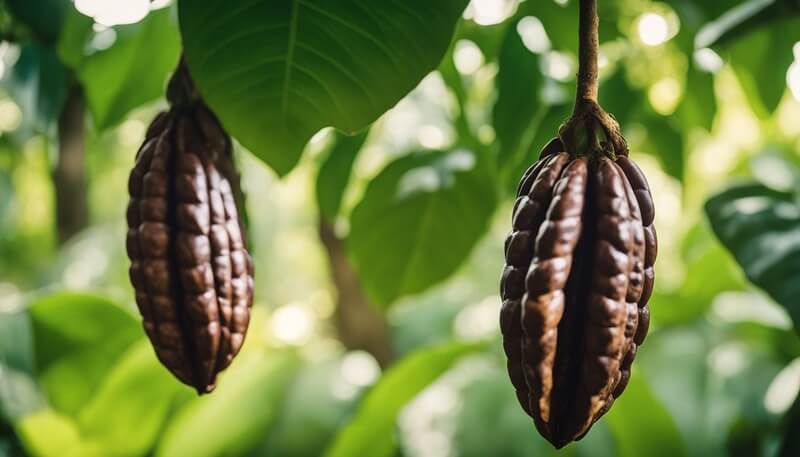
Studies suggest that cacao may help reduce inflammation and improve skin health. These benefits can be particularly useful in managing conditions like chronic inflammation and supporting healthy aging.
Potentials for Reducing Inflammation
Cacao is rich in flavonoids, which are plant compounds with anti-inflammatory properties. Research indicates that consuming cacao can help lower inflammation levels.
This is beneficial because chronic inflammation is linked to various health issues like heart disease.
Flavonoids in cacao enhance nitric oxide production. Improved nitric oxide levels help relax blood vessels, leading to better circulation. Enhanced circulation may contribute to reduced inflammation.
Cacao consumption has shown promising results in reducing markers of inflammation in various studies.
Cacao’s Role in Skin Health
The antioxidants in cacao help fight free radicals, which contribute to skin aging. By protecting the skin from oxidative stress, these antioxidants can help maintain a youthful appearance.
Additionally, cacao’s anti-inflammatory properties can soothe inflamed skin. This is particularly useful for conditions such as acne and eczema.
Cacao may also improve skin hydration and texture, leading to smoother and more radiant skin.
For more information on the health benefits of cacao, including its effects on inflammation and skin health, visit this page.
Cacao in Diet and Recipes
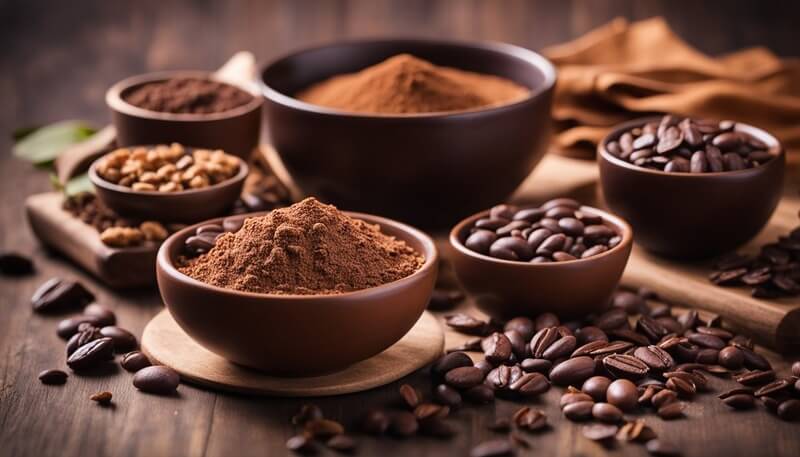
Cacao is a versatile ingredient that can be used in many ways. It adds rich flavor to beverages and baked goods and can serve as a nutritional supplement.
Incorporating Cacao in Beverages
Cacao powder can be a delicious addition to drinks.
Smoothies often feature cacao powder mixed with bananas, almond milk, and spinach. This not only enhances the flavor but also boosts the nutritional content.
People love making hot chocolate with raw cacao powder. They mix it with milk and sweeteners like honey or agave.
This drink is not only comforting but also packed with antioxidants.
Oatmeal can be made tastier by stirring in some cacao powder or cacao nibs, adding both flavor and crunch.
Related: Review of the Best Ceremonial Cacao you can buy online
Baking and Cooking with Cacao
Cacao is popular in baking.
Cacao powder is often used to give baked goods such as cookies, brownies, and cakes a rich chocolate taste.
For example, a flourless cacao fudge cake combines cacao powder with eggs, brown sugar, almond meal, and butter.
Cacao nibs can be sprinkled on baked goods like muffins or mixed into cookie dough. This not only provides a chocolatey flavor but also adds texture.
Even savory dishes benefit from cacao, like using it in mole sauce for an extra layer of depth.
Cacao as a Nutritional Supplement
Cacao is rich in nutrients like magnesium and iron.
Some people enjoy adding cacao nibs to their diet because they undergo minimal processing and retain most nutrients.
Adding cacao powder to yogurt or cottage cheese is another way to enjoy its benefits.
It can also be mixed into protein shakes to enhance taste and nutritional value.
Just one tablespoon of cacao powder provides 10% of daily magnesium needs, making it a beneficial supplement for those needing more minerals.
Safety and Consumption Guidelines

Understanding potential allergies and side effects when consuming cacao is essential. It’s also important to follow recommended intake guidelines to avoid adverse effects while benefiting from its nutrients.
Understanding Cacao Allergies and Side Effects
Some people might experience allergic reactions to cacao, including skin rashes, headaches, or stomach discomfort.
Cacao contains caffeine and theobromine, both of which are stimulants. When consumed in large amounts, these compounds can lead to jitters, increased heart rate, or difficulty sleeping.
Some individuals might also experience digestive issues, such as gas or bloating. It’s crucial to monitor how one’s body reacts to cacao and adjust consumption accordingly.
Recommended Intake and Moderation
Experts generally suggest moderate consumption of cacao to reap its benefits without adverse effects.
For many people, this means around 10 to 20 grams of dark chocolate or cacao powder daily.
This amount can vary based on individual health and tolerance to stimulants like caffeine and theobromine.
Too much cacao can lead to unwanted side effects due to its stimulant content.
Incorporating cacao into a balanced diet while being mindful of total daily stimulant intake helps avoid these issues.
Regularly reviewing personal health and adjusting the intake as needed ensures safe and enjoyable consumption.
Frequently Asked Questions
This section answers common questions about the health benefits of cacao for both men and women, along with potential effects on skin health, daily consumption, and more.
1. What does cacao do for the body?
Cacao is rich in antioxidants that help reduce inflammation. It can improve heart health by lowering blood pressure and enhancing blood flow. Additionally, cacao may boost mood by increasing serotonin levels.
2. Is it okay to drink cacao every day?
Yes, consuming cacao in moderate amounts daily is generally safe. It can also provide benefits like improved mood and better heart health.
3. Is cacao a superfood?
Cacao is often considered a superfood because it contains antioxidants, vitamins, and minerals. These nutrients can positively impact various aspects of health.
4. What are the health advantages of consuming cacao for men?
Cacao can improve cardiovascular health for men by reducing blood pressure and enhancing blood circulation. It may also help lower cholesterol levels and reduce the risk of heart disease.
5. How does cacao consumption benefit women’s health?
Cacao’s serotonin-boosting properties can help women stabilize mood swings. It also provides essential minerals like magnesium, which can alleviate symptoms of PMS.
6. Can cacao improve skin health, and if so, how?
Yes, cacao can improve skin health. Its antioxidants help fight free radicals, reducing wrinkles and signs of aging. The anti-inflammatory properties can also help with skin conditions like acne.
7. What are the possible side effects of consuming cacao?
Potential side effects of consuming too much cacao include caffeine-related issues like jitteriness, migraine headaches, or digestive problems. Always consume in moderation.
8. What role does cacao play in spiritual practices?
Cacao is used in spiritual practices to enhance mood and promote mental clarity. It is often used in cacao ceremonies to facilitate meditation and emotional healing.
9. How does the regular intake of cacao affect female fertility?
Some studies suggest that moderate cacao consumption can positively impact female fertility. Thanks to its serotonin-boosting effects, cacao promotes hormonal balance and reduces stress.

